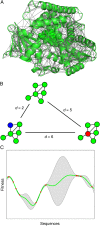Navigating the protein fitness landscape with Gaussian processes
- PMID: 23277561
- PMCID: PMC3549130
- DOI: 10.1073/pnas.1215251110
Navigating the protein fitness landscape with Gaussian processes
Abstract
Knowing how protein sequence maps to function (the "fitness landscape") is critical for understanding protein evolution as well as for engineering proteins with new and useful properties. We demonstrate that the protein fitness landscape can be inferred from experimental data, using Gaussian processes, a Bayesian learning technique. Gaussian process landscapes can model various protein sequence properties, including functional status, thermostability, enzyme activity, and ligand binding affinity. Trained on experimental data, these models achieve unrivaled quantitative accuracy. Furthermore, the explicit representation of model uncertainty allows for efficient searches through the vast space of possible sequences. We develop and test two protein sequence design algorithms motivated by Bayesian decision theory. The first one identifies small sets of sequences that are informative about the landscape; the second one identifies optimized sequences by iteratively improving the Gaussian process model in regions of the landscape that are predicted to be optimized. We demonstrate the ability of Gaussian processes to guide the search through protein sequence space by designing, constructing, and testing chimeric cytochrome P450s. These algorithms allowed us to engineer active P450 enzymes that are more thermostable than any previously made by chimeragenesis, rational design, or directed evolution.
Conflict of interest statement
The authors declare no conflict of interest.
Figures





References
-
- Mandecki W. The game of chess and searches in protein sequence space. Trends Biotechnol. 1998;16:200–202.
-
- Pierce NA, Winfree E. Protein design is NP-hard. Protein Eng. 2002;15(10):779–782. - PubMed
-
- Axe DD. Estimating the prevalence of protein sequences adopting functional enzyme folds. J Mol Biol. 2004;341(5):1295–1315. - PubMed
Publication types
MeSH terms
Substances
Grants and funding
LinkOut - more resources
Full Text Sources
Other Literature Sources
Molecular Biology Databases

